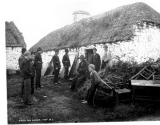
Ballinglass Incident
Encyclopedia
The Ballinlass Incident was the eviction
of 300 tenants on 13 March 1846 in Ireland
, in the context of the Great Famine in Ireland (1845
–1849
).
 At this time, Ireland was part of the United Kingdom of Great Britain and Ireland
At this time, Ireland was part of the United Kingdom of Great Britain and Ireland
, governed directly by its parliament in London. Many working class Irish farmers were tenants under landlords, producing cereals, potato
es and livestock. But only the potatoes remained as food for the farmers themselves; the other products were used for paying the rent and exported from Ireland to Great Britain
. These exports continued when the potato crop failed in 1845.
Farmers who weren't able to pay the rent in this situation were evicted from their homes and land. It is estimated that tens of thousands were evicted during the famine.
The 300 inhabitants of the village of Ballinlass in Galway County were relatively "wealthy" and able to pay their rent. But despite this fact, they were evicted on 13 March 1846 because the landlord, a Mrs Gerrard, intended to establish a grazing farm where the village was situated.
The houses of Ballinlass were demolished by army and police; the people slept in the ruins in the following night. The next day, police and army returned to evict them definitely. Their neighbours were not allowed to take them in.
The eviction of the entire village received wide publicity and was 'personally investigated' by Lord Londonderry, who, in a statement to the House of Lords
on March 30, 1846 said 'I am deeply grieved, but there is no doubt concerning the truth of the evictions at Ballinlass. Seventy six families, comprising 300 individuals had not only been turned out of their houses, but had even - the unfortunate wretches - been mercilessly driven from the ditches to which they had been taken themselves for shelter..these unfortunate people had their rents actually ready..' Despite widespread condemnation, the eviction order was not rescinded.
Eviction
How you doing???? Eviction is the removal of a tenant from rental property by the landlord. Depending on the laws of the jurisdiction, eviction may also be known as unlawful detainer, summary possession, summary dispossess, forcible detainer, ejectment, and repossession, among other terms...
of 300 tenants on 13 March 1846 in Ireland
1846 in Ireland
-Events:*Potato blight affects the country putting farmers in distress.*13 March - Ballinglass Incident: eviction of 300 tenants at the village of Ballinglass during the Irish Potato famine....
, in the context of the Great Famine in Ireland (1845
1845 in Ireland
-Events:*Devon Commission reports to the British government on the poor living conditions of the Irish population: "in many districts their only food is the potato"....
–1849
1849 in Ireland
-Events:* 12 July — Battle of Dolly's Brae: Up to 1400 armed Orangemen march from Rathfriland to Tollymore Park near Castlewellan, County Down. When 1000 armed Ribbonmen gather, shots are fired, Catholic homes are burnt and about eighty Catholics killed....
).

United Kingdom of Great Britain and Ireland
The United Kingdom of Great Britain and Ireland was the formal name of the United Kingdom during the period when what is now the Republic of Ireland formed a part of it....
, governed directly by its parliament in London. Many working class Irish farmers were tenants under landlords, producing cereals, potato
Potato
The potato is a starchy, tuberous crop from the perennial Solanum tuberosum of the Solanaceae family . The word potato may refer to the plant itself as well as the edible tuber. In the region of the Andes, there are some other closely related cultivated potato species...
es and livestock. But only the potatoes remained as food for the farmers themselves; the other products were used for paying the rent and exported from Ireland to Great Britain
Great Britain
Great Britain or Britain is an island situated to the northwest of Continental Europe. It is the ninth largest island in the world, and the largest European island, as well as the largest of the British Isles...
. These exports continued when the potato crop failed in 1845.
Farmers who weren't able to pay the rent in this situation were evicted from their homes and land. It is estimated that tens of thousands were evicted during the famine.
The 300 inhabitants of the village of Ballinlass in Galway County were relatively "wealthy" and able to pay their rent. But despite this fact, they were evicted on 13 March 1846 because the landlord, a Mrs Gerrard, intended to establish a grazing farm where the village was situated.
The houses of Ballinlass were demolished by army and police; the people slept in the ruins in the following night. The next day, police and army returned to evict them definitely. Their neighbours were not allowed to take them in.
The eviction of the entire village received wide publicity and was 'personally investigated' by Lord Londonderry, who, in a statement to the House of Lords
House of Lords
The House of Lords is the upper house of the Parliament of the United Kingdom. Like the House of Commons, it meets in the Palace of Westminster....
on March 30, 1846 said 'I am deeply grieved, but there is no doubt concerning the truth of the evictions at Ballinlass. Seventy six families, comprising 300 individuals had not only been turned out of their houses, but had even - the unfortunate wretches - been mercilessly driven from the ditches to which they had been taken themselves for shelter..these unfortunate people had their rents actually ready..' Despite widespread condemnation, the eviction order was not rescinded.

